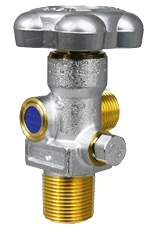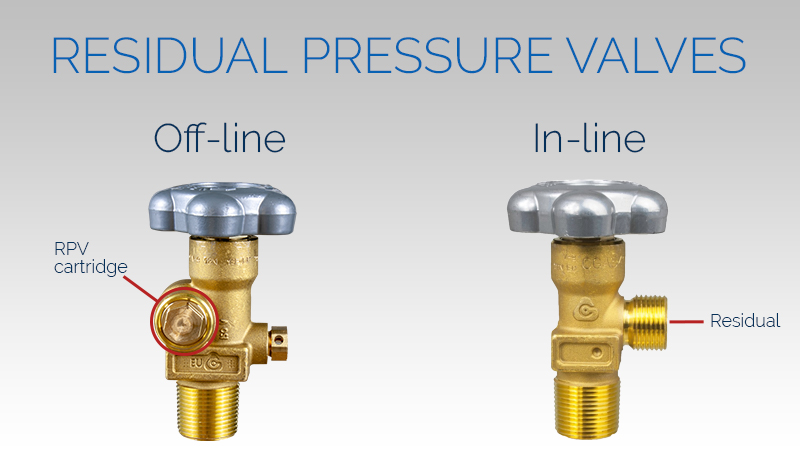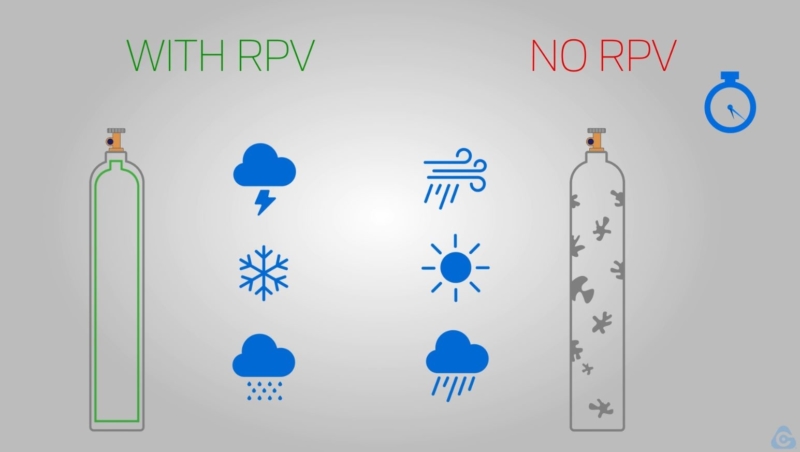Residual Pressure Valves for compressed gases, also known as RPV, are very similar to standard valves and they work just like them. By turning the handwheel, the user opens/closes the valve in order to activate/deactivate the gas flow.
- The RPV technology
- What are Residual Pressure Valves used for?
- The benefits of Residual Pressure Valves


The RPV technology
The Residual Pressure Valves technology was primarily invented by the Japanese in 90s and was introduced into Cavagna’s products range in 1996. Basically, its purpose is to protect the cylinder from contamination due to the income of impurities and external particles. To do this, it requires the help of a cartridge, located in the RPV cassette.
Depending on where the RPV cassette is located, RPVs can be divided into two main categories: in-line and off-line RPVs. By drawing a line from the centre of the cylinder to the centre of the handwheel, you can find the axis. If the RPV cassette is offset from this axis, whereby the RPV cassette is assembled behind the outlet of the valve, the residual pressure valve is an off-line type.
On the other hand, in the in-line case, the RPV cassette is located inside the outlet.
When the cylinder is full
RPV is an automatic system. It uses the concept of forces versus diameter to be opened and closed. Once the gas exits the cylinder, it tends to reach the outlet. It then flows into the RPV cassette where it is blocked by the sealing between the valve body and the O-ring in the RPV cassette. However, the RPV cassette is a motion system too. This means that when the force expressed by the gas pressure on the O-ring in the back of the RPV cassette, overcomes the strength of the spring and the force expressed by the environment on this O-ring, the gas pushes the RPV cassette and squashes this spring. By squashing it, all RPV components are pushed back. At this point there’s no more sealing between the O-ring and the valve body and the gas can escape.
When the cylinder is almost empty
The main function of the RPV cassette is to maintain a certain pressure inside the cylinder. This prevents contamination of the cylinder by atmospheric agents and the ingress of moisture and particles. So that, when the remaining pressure inside the cylinder is less than 4 bar, the force of the spring begins to exceed the gas force. At this point, the RPV cartridge is able to shut off the gas flow, before the cylinder is completely empty.

What are Residual Pressure Valves used for?
As above-mentioned, the RPV allows retention of a positive pressure inside the cylinder, preventing external contamination. This guarantees many advantages in terms of safety and economy.
Let’s start by analysing what normally happens to a cylinder when it’s empty. It is usually stored outside and many factors affect its durability. The temperature exchange between night and day, for example, or the humidity which enters it, causes an oxidation, combined with CO2 then leads to corrosions.
In such cases, contamination by external particles threatens the mechanical strength of the cylinder, causing damage to the cylinder body. Besides safety aspects, this has also an economic impact. When a cylinder with standard valve arrives at the filling centre, the operator must first evacuate the cylinder, in order to provide the customer with the right level of gas purity. ‘Cylinder purging‘ is the name of this process through which the operator creates a vacuum inside the cylinder before filling operations.
The benefits of Residual Pressure Valves
Purging costs time and money as does renewing the cylinder fleet. So, why not switch to an RPV valve instead? Residual pressure valves are a wise investment for your business, as they guarantee:
- Increased safety
- Longer cylinder life
- Faster filling operations
The initial investment in RPV’s may be higher than standard ones but, by choosing them, you can get a better return on investment. For example, have you ever wondered how many fillings per cylinder you could do instead of spending time on purging, or how much purging costs per cylinder? You do the math!


